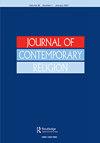Machines for Making Gods: Mormonism, Transhumanism, and Worlds without End
IF 0.6
3区 哲学
0 RELIGION
引用次数: 0
Abstract
poses difficulty with what ‘Mennonite’ means in such contexts. The most obvious statements made by Loewen that he may agree are in Chapter 4, “Making Peace on Earth”, where he concludes that “Perhaps these texts refrain from making a case for a specifically ‘Mennonite’ approach to the land” (118) and that “the link between nonviolence and environmental care is a more recent concern” (123). In his conclusion, he writes: “The stories in this book speak to a common challenge faced by Mennonite farmers around the world, but they also relate to all farmers compelled by the question of sustainable agriculture” (269). I agree with this conclusion, but it undercuts his other assertion that the “lived religion” of “the seven Mennonite communities” play a “crucial role” in their “everyday environmental relations” (265, emphasis in original), at least in terms of any specific ‘Mennonite’ approach. This tension is an interesting conclusion that deserved more attention. Nevertheless, the ethnographic work Loewen and his team have done has produced an impressive collection of reflections on these seven communities that deserve attention by those interested in Mennonite studies and the relationship between religion and agriculture. His description provides an excellent starting point for normative questions—such as: what is a Mennonite understanding of sustainability and how should that understanding guide agricultural practices in diverse Mennonite communities?—but that is not necessarily the work of an historian.造神机器:摩门教、跨人文主义和无尽的世界
在这种情况下,“门诺派”的含义很难理解。Loewen可能同意的最明显的声明是在第4章“在地球上实现和平”中,他得出结论,“也许这些文本没有为具体的‘门诺’土地方法提供理由”(118),“非暴力和环境保护之间的联系是最近才关注的问题”(123)。在他的结论中,他写道:“本书中的故事讲述了世界各地门诺派农民面临的共同挑战,但它们也涉及到所有受可持续农业问题驱使的农民”(269)。我同意这个结论,但它削弱了他的另一个断言,即“七个门诺社区”的“活宗教”在他们的“日常环境关系”中发挥着“关键作用”(265,原文强调),至少在任何特定的“门诺”方法方面是如此。这种紧张关系是一个值得更多关注的有趣结论。尽管如此,Loewen和他的团队所做的民族志工作对这七个社区产生了令人印象深刻的思考,值得那些对门诺派研究以及宗教与农业之间关系感兴趣的人关注。他的描述为规范性问题提供了一个很好的起点,比如:门诺派对可持续性的理解是什么,这种理解应该如何指导不同门诺派社区的农业实践--但这不一定是历史学家的工作。
本文章由计算机程序翻译,如有差异,请以英文原文为准。
求助全文
约1分钟内获得全文
求助全文
来源期刊

Journal of Contemporary Religion
RELIGION-
CiteScore
1.20
自引率
0.00%
发文量
59
期刊介绍:
Journal of Contemporary Religion is an international peer reviewed journal. Its purpose is to both document and evaluate the anthropological, sociological, psychological, and philosophical aspects of emerging manifestations of religiosity in any part of the world—whether within innovative movements or mainstream institutions. The term ''religion'' in the title of this journal is understood to include contributions on spirituality. Moreover, as the journal title suggests, the focus is on contemporary issues. Therefore, the editors of Journal of Contemporary Religion welcome submissions which deal with: classical topics in the study of religion, such as secularisation and the vitality of religion or traditional sectarian movements; more recent developments in the study of religion, including religion and social problems, religion and the environment, religion and education, the transmission of religion, the materialisation and visualisation of religion in various forms, new forms of religious pluralism, the rise of new forms of religion and spirituality, religion and the Internet, religion and science, religion and globalisation, religion and the economy, etc. theoretical approaches to the study of religion; discussions of methods in relation to empirical research; qualitative and quantitative research and related issues. The Journal includes reviews of books which reflect the above themes.
 求助内容:
求助内容: 应助结果提醒方式:
应助结果提醒方式:


